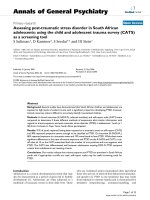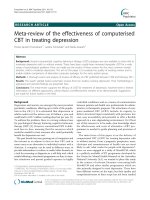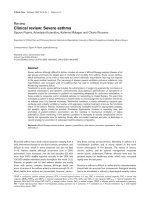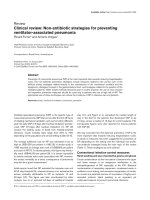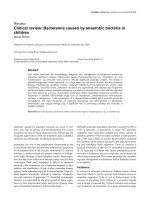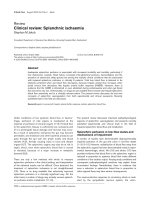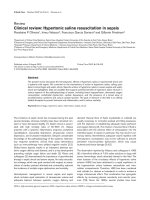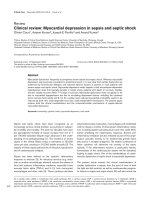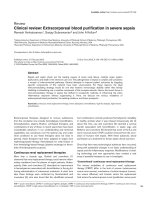Báo cáo y học: "Clinical review: High-frequency oscillatory ventilation in adults — a review of the literature and practical applications" ppsx
Bạn đang xem bản rút gọn của tài liệu. Xem và tải ngay bản đầy đủ của tài liệu tại đây (100.69 KB, 6 trang )
385
∆P = oscillatory pressure amplitude; ARDS = acute respiratory distress syndrome; FiO
2
= fractional inspired concentration of oxygen; HFOV =
high-frequency oscillatory ventilation; PaO
2
= pressure of arterial oxygen; P
aw
= mean airway pressure; PEEP = positive end-expiratory pressure;
V
t
= tidal volume.
Available online />Introduction
The development of the positive pressure mechanical ventila-
tor in the 1950s marked a significant achievement in the care
of patients with respiratory failure, and was a cornerstone in
the establishment of the discipline of critical care medicine.
Since then, we have learned that although mechanical ventila-
tion is often life saving, it can also be injurious, especially in
patients suffering from acute respiratory distress syndrome
(ARDS) [1]. ARDS can also result in refractory hypoxemia,
which can often stimulate attempting nonconventional ventila-
tion strategies such as using nitric oxide, recruitment maneu-
vers, or prone positioning. High-frequency oscillatory
ventilation (HFOV) has emerged as one such rescue strategy
for adults with ARDS. Moreover, given that it appears to
injure the lung less than conventional modes of ventilation, it
may also be ideally suited to use early in ARDS.
HFOV fits within the spectrum of the other high-frequency
ventilation modes whose common underlying concept is the
delivery of breaths at high frequencies and low tidal volumes
(V
t
), which are often below the anatomic dead space. The
high-frequency modes are generally divided into those in
which the expiratory phase is passive and those in which
expiration is active. High-frequency jet ventilation and high-
frequency positive pressure ventilation are examples of
devices employing passive expiration.
High-frequency positive pressure ventilation was first devel-
oped in the 1960s and typically uses a flow generator that is
Review
Clinical review: High-frequency oscillatory ventilation in adults —
a review of the literature and practical applications
Frank V Ritacca
1
and Thomas E Stewart
2,3
1
Clinical Fellow, Division of Respirology and Interdepartmental Division of Critical Care Medicine, University of Toronto, Toronto, Ontario, Canada
2
Associate Professor, Division of Respirology and Interdepartmental Division of Critical Care Medicine, University of Toronto, Toronto, Ontario, Canada
3
Director, Critical Care Unit, Mount Sinai Hospital and University Health Network, University of Toronto, Toronto, Ontario, Canada
Correspondence: Thomas E Stewart ()
Published online: 17 April 2003 Critical Care 2003, 7:385-390 (DOI 10.1186/cc2182)
This article is online at />© 2003 BioMed Central Ltd (Print ISSN 1364-8535; Online ISSN 1466-609X)
Abstract
It has recently been shown that strategies aimed at preventing ventilator-induced lung injury, such as
ventilating with low tidal volumes, can reduce mortality in patients with acute respiratory distress
syndrome (ARDS). High-frequency oscillatory ventilation (HFOV) seems ideally suited as a lung-
protective strategy for these patients. HFOV provides both active inspiration and expiration at
frequencies generally between 3 and 10 Hz in adults. The amount of gas that enters and exits the lung
with each oscillation is frequently below the anatomic dead space. Despite this, gas exchange occurs
and potential adverse effects of conventional ventilation, such as overdistension and the repetitive
opening and closing of collapsed lung units, are arguably mitigated. Although many investigators have
studied the merits of HFOV in neonates and in pediatric populations, evidence for its use in adults with
ARDS is limited. A recent multicenter, randomized, controlled trial has shown that HFOV, when used
early in ARDS, is at least equivalent to conventional ventilation and may have beneficial effects on
mortality. The present article reviews the principles and practical aspects of HFOV, and the current
evidence for its application in adults with ARDS.
Keywords acute lung injury, acute respiratory distress syndrome, high-frequency oscillatory ventilation,
mechanical ventilation, ventilator-induced lung injury
386
Critical Care October 2003 Vol 7 No 5 Ritacca and Stewart
time cycled and achieves flow rates of 175–250 l/min. The res-
piratory rate is usually 60–100 breaths/min and achieves V
t
values of 3–4 ml/kg. Although theoretically attractive, this mode
seems to offer little advantage over conventional ventilation in
patients with lung injury and, as such, application is limited. In
high-frequency jet ventilation, gas is delivered through a small
cannula under high pressures (70–350 kPa) and, combined
with entrainment of humidified gas by the Venturi effect, ade-
quate tidal volumes are achieved. Although high-frequency jet
ventilation is sometimes used in patients with bronchopleural
fistulae, most centers limit their use to rescue situations. For
more detailed reviews of these modes of ventilation, the reader
is referred to a few of the many reviews on these topics [2,3].
HFOV is similar to other high-frequency modes in that effec-
tive oxygenation is achieved by the application of high mean
airway pressure (P
aw
). As previously discussed, however,
HFOV differs in that expiration is an active process controlled
by the ventilator. Theoretically, this results in improved CO
2
elimination and reduced gas trapping. The present article
reviews the rationale for the use of HFOV as a ventilatory
strategy in adults, reviews practical issues for intensivists
using this modality, and reviews the evidence supporting its
use in adult patients with ARDS.
A need for novel modes of ventilation
Despite the fact that patients with respiratory failure often
require positive pressure mechanical ventilation, it has
become clear that mechanical ventilation using conventional
strategies can be harmful. Gross barotrauma resulting in extra-
parenchymal air in the forms of pneumothorax, pneumomedi-
astinum, or subcutaneous emphysema are obvious examples
of the detrimental effects of mechanical ventilation [4].
However, more subtle microscopic damage can also occur in
lungs that have been subjected to mechanical ventilation.
This damage has been termed ventilator-induced lung injury,
and can mimic the histological, radiographic, and clinical
changes that occur in patients with ARDS [5]. The damage is
thought to result from excess airway pressures (barotrauma),
from high lung volumes (volutrauma), or from the repetitive
opening and closing of collapsed lung units with successive
tidal breaths (atelectrauma) [6]. Evidence for this comes from
numerous studies in animals, which have shown that the ven-
tilator can induce pathologic changes in normal lungs and
have shown that strategies minimizing these effects are bene-
ficial [6–9]. In addition, we now know that lung injury itself
(ventilator induced or otherwise) can propagate the proin-
flammatory cytokine cascade (biotrauma) and can contribute
to the development of multisystem organ failure in humans
with ARDS [10,11]. It is important to note that multisystem
organ failure is often the cause of death in those patients that
die from ARDS [12–14].
Previous ventilator strategies have focused on normalization
of arterial blood gases [15]. The tidal volumes and subse-
quent airway pressures needed to achieve these goals are
typically safe in normal lungs; however, it is currently felt that
these levels are probably injurious in patients with lung injury,
where the same volumes are delivered to a much smaller lung
volume, resulting in overdistension [16]. Two large random-
ized, controlled trials in humans with ARDS have shown that
ventilatory strategies limiting overdistension using low tidal
volumes can have a mortality benefit [17,18]. One of these
studies also included efforts to recruit collapsed lung units
and to keep these units open [18]. The benefit of ‘opening’
the lung either with recruitment maneuvers, with application
of higher levels of positive end-expiratory pressure (PEEP), or
with high P
aw
, such as that achieved with HFOV, is more con-
troversial because recruitment with any of these strategies
can result in overdistension of more ‘normal’ lung regions.
Overall, the use of these techniques is supported by a large
body of animal literature for the use of PEEP [19–22] and, to
a lesser degree, by clinical trials [18,23,24]. There is also
some suggestion that the benefit of recruitment maneuvers
themselves depends on several patient-specific factors [25].
Lung protective strategies in ARDS are currently aimed at
reducing plateau airway pressures and tidal volumes, and at
attempting to have an open lung [26]. Based on this ratio-
nale, the high P
aw
in conjunction with small V
t
values appears
to make HFOV ideally suited as a lung protective strategy.
High-frequency oscillatory ventilation
The potential of high-frequency ventilation in humans has
been studied since the observation that adequate gas
exchange occurred in panting dogs with tidal volumes lower
than the anatomic dead space [27]. In the 1970s, groups in
Germany and Canada found a system that oscillated gas into
and out of an animal’s lungs was effective at CO
2
elimination
[28,29]. Commercial products are now available for children
and for adults.
These ventilators operate on the following principle (Fig. 1). A
bias flow of fresh, heated, humidified gas is provided across
the proximal endotracheal tube. The bias flow is typically set
at 20–40 l/min, and the P
aw
at the proximal endotracheal tube
is set at a relatively high level (25–35 cmH
2
O). An oscillating
piston pump akin to the woofer of a loudspeaker vibrates this
pressurized, flowing gas at a frequency that is generally set
between 3 and 10 Hz. A portion of this flow is thereby
pumped into and out of the patient by the oscillating piston.
The P
aw
achieved is sensitive to the rate of bias flow but can
be adjusted by varying the back pressure on the mushroom
valve through which the bias flow vents into the room. The
P
aw
can thus be modified by either adjusting the bias flow
rate or the back pressure.
The set power on the ventilator controls the distance that the
piston pump moves and, hence, controls the V
t
. The result is
a visible wiggle of the patient’s body, which is typically
titrated to achieve acceptable CO
2
elimination. The oscilla-
387
tory pressure amplitude (∆P) is measured in the ventilator
circuit and is therefore only a surrogate of the actual pressure
oscillations in the airways. These pressures are generally
greatly attenuated through the endotracheal tube and larger
airways so the pressure swings in the alveoli are much less.
The P
aw
, on the other hand, is believed to be similar in the
ventilator circuit and the alveoli.
The operator uses the parameters of power (which results in
∆P) and frequency (reductions in which improve CO
2
clear-
ance) to manipulate the V
t
. It seems counterintuitive that reduc-
tions in frequency would improve alveolar ventilation; however,
HFOV differs from conventional ventilation in that the lung
never achieves an equilibrium volume during inspiration and
expiration. Lowering the frequency therefore allows more time
for a larger V
t
to occur. With HFOV, CO
2
elimination is propor-
tional to the V
t
and the frequency, but increases in the V
t
achieved by lowering the frequency are thought to more than
compensate for the reduction in frequency. It is also important
to note that the actual V
t
received by the patient depends on a
number of factors, including the size of the endotracheal tube,
the airway resistance, and the compliance of the total respira-
tory system. Unfortunately, there are no predictable relation-
ships between power and ∆P with the V
t
received by the
patient. In addition, the V
t
can change on a breath-to-breath
basis, and therefore ventilator settings are used with clinical
factors such as the amount of wiggle in monitoring the patient.
As with conventional ventilation, oxygenation is primarily
determined by the P
aw
, by the lung volume, and by the frac-
tional inspired concentration of oxygen (FiO
2
). The initial set-
tings are typically chosen to achieve a P
aw
value roughly
5 cmH
2
O greater than that achieved with conventional venti-
lation. Failure to adequately oxygenate the patient is fre-
quently remedied by increasing the P
aw
or the FiO
2
. There is
no evidence guiding exactly how ventilator adjustments
should be made in the hypoxemic patient on HFOV. Gener-
ally, when FiO
2
> 0.6, our approach has been to increase the
P
aw
. These increases are made slowly to give time for alveolar
recruitment and to assess for cardiovascular impairment. In
addition, these increases are frequently made in conjunction
with a recruitment maneuver. P
aw
values as high as
35–45 cmH
2
O have been used and tolerated [30,31]. In our
experience, a higher P
aw
may result in hemodynamic impair-
ment, especially if the intravascular volume is inadequate.
Should significant derecruitment from oscillator disconnects
or circuit changes occur, our experience suggests that
recruitment maneuvers are also helpful in this situation. Many
pediatric and adult trials using HFOV (discussed later),
however, have not utilized such an approach. Once the
patient improves and the FiO
2
can be decreased to below
0.6–0.4, the P
aw
is generally weaned slowly, decreasing P
aw
by 1–2 cmH
2
O and assessing response.
As already described, one of the theoretical advantages of
HFOV over other high-frequency modes is the decoupling of
oxygenation and CO
2
elimination. Ventilation is determined by
changes in power (a surrogate for V
t
) and in frequency.
Simply increasing the power will often result in improved ven-
tilation. Once this is maximized, the frequency can be
reduced. One must, however, keep in mind that these steps
may lead to larger tidal volumes (as already mentioned) and
to larger pressure swings at the alveoli, and as a result may
lead to the potential to negatively impact on lung protection
[30–32]. Finally, deflation of the endotracheal tube cuff may
help eliminate CO
2
by allowing the front of fresh gas to be
advanced to the distal end of the endotracheal tube, allowing
a slight reduction of the anatomic dead space, which may be
significant in situations when the V
t
is small. However, this
may sacrifice the ability to maintain a high P
aw
.
Potential disadvantages of HFOV
Patients on HFOV often require heavy sedation and/or neuro-
muscular blockade, which may be problematic, especially in
view of evidence supporting a benefit to daily wakening of
sedated mechanically ventilated patients [33]. Such an
approach is often not possible in patients requiring HFOV.
Suctioning patients on HFOV can be achieved using a closed
inline system that does not require the patient to be discon-
nected from the oscillator. The extent to which this prevents
derecruitment is not clear. In addition, a higher P
aw
may
explain the reductions in cardiac preload that are occasionally
seen with HFOV. Consequently, fluid balance needs to be
carefully monitored as hypoxemia can, at times, be exacer-
bated by relative hypovolemia. Transportation out of the inten-
sive care unit on the oscillator is currently not possible.
Procedures like bronchoscopy may also lead to loss of P
aw
.
Other potential disadvantages include loss of the ability to
auscultate the lung, the heart, and the abdomen, and difficulty
in recognizing pneumothorax, right mainstem bronchus intu-
bation, and endotracheal tube dislodgement (in these situa-
tions, patient wiggle will decrease and ∆P will increase).
Available online />Figure 1
Schematic representing the major functioning parts of the high-
frequency oscillatory ventilator. See text for a detailed explanation.
Reproduced with permission from SensorMedics, Yorba Linda,
California, USA [www.viasyshealthcare.com].
388
Patients are switched back to conventional mechanical venti-
lation when they are able to tolerate a lower P
aw
(currently
20–24 cmH
2
O). However, the ideal timing is unknown and
further work is required. Unlike in neonates, we know of no
experience with transitioning adults directly to extubation from
HFOV. The modest bias flow rates, which for the most part
are insufficient to allow spontaneous respiratory efforts, are
probably the primary reason that this has not occurred.
Evidence for use of HFOV in adults
The use of HFOV has been extensively studied in the neonatal
and pediatric populations. A number of studies did not show
any significant benefit of HFOV over conventional ventilation in
preventing chronic lung disease [34–37]. Two further studies
have recently been released regarding HFOV in neonates, and
are two of the largest to date in this field. Johnson and col-
leagues randomized 800 infants to HFOV versus conventional
ventilation, and found no significant difference in mortality
rates, chronic lung disease, or adverse events in the two
groups [38]. In contrast, the study by Courtney and col-
leagues, which randomized a similar number of infants, found
a significant benefit of HFOV over conventional ventilation in
terms of earlier extubation and survival without oxygen therapy
[39]. This study differed in that the infants were very high risk
(600–1200 g at birth) and the ventilation protocols were more
tightly controlled, suggesting that HFOV might be most useful
if used in a uniform way in a well-defined population [40]. In
contrast to the number of studies in neonates, where HFOV
appears to have found a permanent home, evidence for HFOV
in adults with lung injury is limited.
HFOV has until recently mostly been investigated as a rescue
therapy for patients with ARDS who are failing conventional
mechanical ventilation, because of difficulty in achieving either
adequate ventilation or oxygenation within safe ventilator para-
meters. Two case series with a total of 41 ARDS patients pro-
vided encouraging results suggesting that HFOV may be
beneficial in these patients [30,31]. Mehta and colleagues
studied 24 patients with severe ARDS (lung injury score =
3.4 ± 0.6 [41], pressure of arterial oxygen [PaO
2
]/FiO
2
ratio =
98.8 ± 39.0) failing conventional ventilation (determined by
ongoing hypoxemia or high plateau pressures), and showed
that HFOV could achieve an improvement in the PaO
2
/FiO
2
ratio within 8 hours [31]. Fort and colleagues studied
17 patients also with severe ARDS (lung injury score =
3.81 ± 0.23, PaO
2
/FiO
2
ratio = 68.6 ± 21.6) deemed to be
failing conventional ventilation, and found similar improve-
ments in oxygenation [30]. Both studies suggested that mor-
tality was improved in patients who had fewer pre-oscillator
ventilator days. Although refractory hypoxemia can be prob-
lematic in managing patients with ARDS, multiple organ failure
(possibly exacerbated by biotrauma) is often the cause of the
patient’s death [12–14]. It is therefore reasonable to assume
that any ventilation strategy, if it is to be effective at achieving
a mortality benefit, must be applied early in the course of
illness and/or before biotrauma begins.
A prospective, multicenter, randomized study has recently
been published. The Multicenter Oscillatory Ventilation for
Acute Respiratory Distress Syndrome Trial investigators ran-
domized 150 patients with ARDS to HFOV (starting fre-
quency = 5 Hz, P
aw
= 5 cmH
2
O greater than that on
conventional ventilation) or to conventional ventilation using
pressure control, with aims of achieving a V
t
of 6–10 cm
3
/kg
actual body weight [42]. The patients in this study were venti-
lated conventionally for an average of 2–4 days prior to ran-
domization. The primary outcome measure was survival
without need for mechanical ventilation at 30 days. There was
no significant difference between groups in the primary
outcome measure. However, there was a nonsignificant trend
towards a lower mortality at 30 days with HFOV versus con-
ventional ventilation (37% versus 52%, P = 0.102). This trial
was only powered to detect equivalency, and therefore inter-
preting trends in the data should be done with caution. In
addition, there was a significant improvement in the
PaO
2
/FiO
2
ratio (P = 0.008) with HFOV for the first 24 hours,
but this effect did not persist. Similar to the previous uncon-
trolled studies, the use of HFOV appeared to be safe, with no
increased rates of barotrauma or hemodynamic instability. It
should be noted that the control arm of this study may not be
considered the gold standard of ventilation in ARDS today,
and volume recruitment maneuvers, which may be important
[43], were not incorporated into either arm of this study or
any of the previous pilot studies of HFOV in adults [30,31].
Despite this, the results are very encouraging and point to the
need for further investigation.
There are several unanswered questions regarding HFOV in
adults. These include the ideal timing of the intervention, the
proper use of adjuncts like volume recruitment maneuvers,
prone position, or nitric oxide, the ideal timing of discontinua-
tion, the proper methods to manipulate the various indices
such as P
aw
, ∆P, and frequency, and the effects on long-term
outcomes such as lung function.
Conclusion
It is becoming increasingly clear that conventional mechanical
ventilation can lead to lung injury through overdistension, high
pressures, and recurrent opening and closing of collapsed
alveoli, all possibly mediated through the release of proinflam-
matory mediators. HFOV seems ideally suited as a lung protec-
tive strategy because of its theoretical ability to minimize many
of these potential adverse effects. Although many studies of
HFOV in neonates and in pediatric populations have been per-
formed and have shown it to be a safe alternative to conven-
tional ventilation, studies in adults with ARDS are few in
number, and it is unclear whether HFOV truly offers benefit
over the current best conventional strategies. In addition, many
of the theoretical benefits of HFOV are unproven, and the lung
volumes achieved while using high mean airway pressures and
various frequencies are unknown. Despite advances in
mechanical ventilation, mortality for ARDS remains high. Mea-
sures that potentially reduce mortality or intensive care unit
Critical Care October 2003 Vol 7 No 5 Ritacca and Stewart
389
length of stay deserve further investigation. HFOV may repre-
sent advancement in care of these patients, although the
optimal strategy of use in adults remains unknown.
Competing interests
None declared.
References
1. Dreyfuss D, Saumon G: Ventilator-induced lung injury: lessons
from experimental studies. Am J Respir Crit Care Med 1998,
157:294-323.
2. Hess D, Mason S, Branson R: High-frequency ventilation.
Respir Care Clin North Am 2001, 7:577-598.
3. MacIntyre NR: High-frequency jet ventilation. Respir Care Clin
North Am 2001, 7:599-610.
4. Haake R, Schlichtig R, Ulstad DR, Henschenn RR: Barotrauma.
Pathophysiology, risk factors, and prevention. Chest 1987,
91:608-613.
5. Slutsky AS: Lung injury caused by mechanical ventilation.
Chest 1999, 1(suppl):S9-S15.
6. Dreyfuss D, Basset G, Soler P, Saumon G: Intermittent positive
pressure hyperventilation with high inflation pressures pro-
duces pulmonary microvascular injury in rats. Am Rev Respir
Dis 1985, 132:880-884.
7. Kolobow T, Moretti MP, Fumagalli R, Mascheroni P, Prato P, Chen
V, Joris M: Severe impairment in lung function induced by high
peak airway pressure during mechanical ventilation. An
experimental study. Am Rev Respir Dis 1987, 135:312-315.
8. Tsuno K, Miura K, Takeya M, Kolobow T, Morioka T: Histopatho-
logic pulmonary changes from mechanical ventilation at high
peak airway pressures. Am Rev Respir Dis 1991, 143:1115-
1120.
9. Webb HH, Tierney DF: Experimental pulmonary edema due to
intermittent positive pressure ventilation with high inflation
pressures. Protection by positive end-expiratory pressure. Am
Rev Respir Dis 1974, 110:556-565.
10. Ranieri VM, Suter PM, Tortorella C, De Tullio R, Dayer JM, Brienza
A, Bruno F, Slutsky AS: Effect of mechanical ventilation on
inflammatory mediators in patients with acute respiratory dis-
tress syndrome: a randomized controlled trial. JAMA 1999,
282:54-61.
11. Slutsky AS, Tremblay LN: Multiple system organ failure. Is
mechanical ventilation a contributing factor? Am J Respir Crit
Care Med 1998, 157:1721-1725.
12. Fowler AA, Hamman RF, Good JT, Benson KN, Baird M, Eberle
DJ, Petty TL, Hyers TM: Adult respiratory distress syndrome:
risk with common predispositions. Ann Intern Med 1983,
98:593-597.
13. Montgomery AB, Stager MA, Carrico CJ, Hudson LD: Causes of
mortality in patients with the adult respiratory distress syn-
drome. Am Rev Respir Dis 1985, 132:485-489.
14. Sloane PJ, Gee MH, Gottlieb JE, Albertine KH, Peters SP, Burns
JR, Machiedo G, Fish JE: A multicenter registry of patients with
acute respiratory distress syndrome. Physiology and
outcome. Am Rev Respir Dis 1992, 146:419-426.
15. Tobin MJ: Mechanical ventilation. N Engl J Med 1994,
330:1056-1061.
16. Rouby JJ, Lu Q, Goldstein I: Selecting the right level of positive
end-expiratory pressure in patients with acute respiratory dis-
tress syndrome. Am J Respir Crit Care Med 2002, 165:1182-
1186.
17. The Acute Respiratory Distress Syndrome Network: Ventilation
with lower tidal volumes as compared with traditional tidal
volumes for acute lung injury and the acute respiratory dis-
tress syndrome. N Engl J Med 2000, 342:1301-1308.
18. Amato MB, Barbas CS, Medeiros DM, Magaldi RB, Schettino GP,
Lorenzi-Filho G, Kairalla RA, Deheinzelin D, Munoz C, Oliveira R,
Takagaki TY, Carvalho C: Effect of a protective-ventilation strat-
egy on mortality in the acute respiratory distress syndrome. N
Engl J Med 1998, 338:347-354.
19. Corbridge TC, Wood LDH, Crawford GP, Chudoba MJ, Yanos J,
Sznajder JI: Adverse effects of large tidal volume and low
PEEP in canine acid aspiration. Am Rev Respir Dis 1990,
142:311-315.
20. Sandhar BK, Niblett DJ, Argiras EP, Dunmill MS, Sykes MK:
Effects of positive end-expiratory pressure on hyaline mem-
brane formation in a rabbit model of the neonatal respiratory
distress syndrome. Intensive Care Med 1988, 14:538-546.
21. Muscedere JG, Mullen JBM, Gan K, Slutsky AS: Tidal volume at
low airway pressures can augment lung injury. Am Rev Respir
Dis 1994, 149:1327-1334.
22. McCulloch PR, Forkert PG, Froese AB: Lung volume mainte-
nance prevents lung injury during high frequency oscillatory
ventilation in surfactant deficient rabbits. Am Rev Respir Dis
1988, 137:1185-1192.
23. Lapinsky SE, Aubin M, Mehta S, Boiteau P, Slutsky AS: Safety
and efficacy of a sustained inflation for alveolar recruitment in
adults with respiratory failure. Intensive Care Med 1999, 25:
1297-1301.
24. Grasso S, Mascia L, Del Turco M, Malacarne P, Giunta F,
Brochard L, Slutsky AS, Ranieri VM: Effects of recruiting
maneuvers in patients with acute respiratory distress syn-
drome ventilated with protective ventilatory strategy. Anesthe-
siology 2002, 96:795-802.
25. Vieira SR, Puybasset L, Lu Q, Richecoeur J, Cluzel P, Coriat P,
Rouby JJ: A scanographic assessment of pulmonary morphol-
ogy in acute lung injury. Significance of the lower inflection
point detected on the lung pressure–volume curve. Am J
Respir Crit Care Med 1999, 159:1612-1623.
26. Froese, AB: High-frequency oscillatory ventilation for adult
respiratory distress syndrome: let’s get it right this time! Crit
Care Med 1997, 25:906-908.
27. Henderson Y, Chillingsworth F, Whitney J: The respiratory dead
space. Am J Physiol 1915, 38:1-19.
28. Lunkenheimer PP, Frank I, Ising H, Keller, Dickhutt HH: Intrapul-
monary gas exchange during simulated apnea due to
transtracheal periodic intrathoracic pressure changes. Anaes-
thesist 1973, 22:232-238.
29. Bohn DJ, Miyasaka K, Marchak BE, Thompson WK, Froese AB,
Bryan AC: Ventilation by high-frequency oscillation. J Appl
Physiol 1980, 48:710-716.
30. Fort P, Farmer C, Westerman J, Johannigman J, Beninati W, Dolan
S, Derdak S: High-frequency oscillatory ventilation for adult
respiratory distress syndrome — a pilot study. Crit Care Med
1997, 25:937-947.
31. Mehta S, Lapinsky SE, Hallett DC, Merker D, Groll RJ, MacDonald
RJ, Stewart TE: Prospective trial of high-frequency oscillation
in adults with acute respiratory distress syndrome. Crit Care
Med 2001, 29:1360-1369.
32. Hromi JM, Tekeuchi M, Godden S, Kacmarek: Tidal volumes
during high-frequency oscillatory partial liquid ventilation in
an ovine model of adult ARDS [abstract]. Am J Respir Crit
Care Med 2000, 161:A388.
33. Kress JP, Pohlman AS, O’Connor MF, Hall JB: Daily interruption
of sedative infusions in critically ill patients undergoing
mechanical ventilation. N Engl J Med 2000; 342:1471-1477.
34. Ogawa Y, Miyasaka K, Kawano T, Imura S, Inukai K, Okuyama K,
Oguchi K, Togari H, Nishida H, Mishina J: A multicenter random-
ized trial of high frequency oscillatory ventilation as compared
with conventional mechanical ventilation in preterm infants
with respiratory failure. Early Hum Dev 1993, 32:1-10.
35. Rettwitz-Volk W, Veldman A, Roth B, Vierzig A, Kachel W, Varn-
holt V, Schlosser R, von Loewenich V: A prospective, random-
ized, multicenter trial of high-frequency oscillatory ventilation
compared with conventional ventilation in preterm infants
with respiratory distress syndrome receiving surfactant.
J Pediatr 1998, 132:249-254.
36. Thome U, Kossel H, Lipowsky G, Porz F, Furste HO, Genzel-
Boroviczeny O, Troger J, Oppenmann HC, Hogel J, Pohlandt F:
Randomized comparison of high-frequency ventilation with
high-rate intermittent positive pressure ventilation in preterm
infants with respiratory failure. J Pediatr 1999, 135:39-46.
37. Moriette G, Paris-Llado J, Walti H, Escande B, Magny JF, Cam-
bonie G, Thiriez G, Cantagrel S, Lacaze-Masmonteil T, Storme L,
Blanc T, Liet JM, Andre C, Salanave B, Breart G: Prospective
randomized multicenter comparison of high-frequency oscil-
latory ventilation and conventional ventilation in preterm
infants of less than 30 weeks with respiratory distress syn-
drome. Pediatrics 2001, 107:363-372.
38. Johnson AH, Peacock JL, Greenough A, Marlow N, Limb ES,
Marston L, Calvert SA: High-frequency oscillatory ventilation
Available online />390
for the prevention of chronic lung disease of prematurity. N
Engl J Med 2002, 347:633-642.
39. Courtney SE, Durand DJ, Asselin JM, Hudak ML, Aschner JL,
Shoemaker CT: High-frequency oscillatory ventilation versus
conventional mechanical ventilation for very-low-birth-weight
infants. N Engl J Med 2002, 347:643-652.
40. Stark AR: High-frequency oscillatory ventilation to prevent
bronchopulmonary dysplasia — are we there yet? N Engl J
Med 2002, 347:682-684.
41. Murray JF, Matthay MA, Luce JM, Flick MR: An expanded defini-
tion of the adult respiratory distress syndrome. Am Rev Respir
Dis 1988, 138:720-723.
42. Derdak S, Mehta S, Stewart TE, Smith T, Rogers M, Buchman
TG, Carlin B, Lowson S, Granton J: The Multicenter Oscillatory
Ventilation for Acute Respiratory Distress Syndrome Trial
(MOAT) study investigators: high-frequency oscillatory venti-
lation for acute respiratory distress syndrome in adults: a ran-
domized, controlled trial. Am J Respir Crit Care Med 2002,
166:801-808.
43. Froese AB, Butler PO, Fletcher WA, Byford LJ: High-frequency
oscillatory ventilation in premature infants with respiratory
failure: a preliminary report. Anesth Analg 1987, 66:814-824.
Critical Care October 2003 Vol 7 No 5 Ritacca and Stewart
